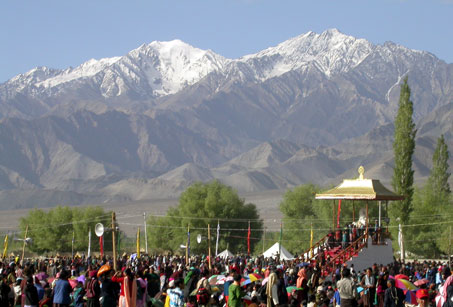
Devotees gather at Choglamsar
Jayashree returned to Leh after four days at SECMOL. She climbed up to the Shanti Stupa, and on the way back meandered through Changspa, which is full of streams, stone walls, narrow paths, old mud houses, and the occasional hotel, restaurant, or shop for tourists.
The last four days of our stay in Ladakh coincided with His Holiness the 14th Dalai Lama's visit there. Each morning on these four days the Dalai Lama preached at Choglamsar, a few kilometers from Leh on the banks of the Indus. We found the neighbouring villages deserted - everyone seemed to have gone to listen to the Dalai Lama. Leh town was quiet too, and most of the shops were closed in the mornings.
We attended the third day of the meeting. The way to Choglamsar was lined with vehicles waiting to get there, while on both sides of the road walked determined Ladakhis: monks and laypersons, old and young, women with babies tied behind them, people on crutches too. Security arrangements outside the large grounds were friendly but thorough - we were frisked and our bags checked. Feeling slightly guilty for the privilege, we sat in an enclosure made for foreigners and tourists, close to the Dalai Lama's pavilion.

Devotees gather at Choglamsar
The meeting was to start at 8 am; the Dalai Lama arrived in a procession at 7:50 am to the sounds of drums and trumpets. For a gathering of between five and ten thousand people, it was remarkably quiet, efficient and well organised. The monks sat on small carpets which were rolled up after the meeting. Volunteers served tea to anyone who had brought their own cup.
The Dalai Lama's talk, which started after mass prayers, was in Tibetan, translated simultaneously into English and at intervals into Ladakhi. (He once corrected an inaccuracy in the Ladakhi translation.) He read and commented upon two texts, first Tsongkhapa's "Three Principal Aspects of the Path" and then Atisha's "The Bodhisattava Garland of Gem". The first was on a very high philosophical plane, for example:
The two understandings of the infallibility of appearance of dependent relation
And the empty that is devoid of assertion
So long as they are viewed as unrelated
Still one has not realized the intention of the Buddha.
The Dalai Lama's commentary upon the text was equally abstract and metaphysical, involving lengthy discussions of mind, existence, non-existence, using some (to us) rather technical terms ("interdependent origination" was a common one). Occasionally he illustrated a point with a short anecdote or parable. For example, while explaining that the phenomena of the world are mere designations of our minds, i.e. illusions, he pointed out that, while we speak of the life stages of a tree--planting, growth, maturity, disintegration--in fact the tree begins to disintegrate the moment it comes into existence: production and disintegration happen simultaneously in all beings. Obviously, being uneducated in Buddhism and arriving on the third day of the lecture series, there was no way we could seriously understand what the Dalai Lama was preaching. What was striking was that, not only is Buddhism the only major world religion with serious metaphysical underpinnings, but such lofty philosophy actually enters into the practice of the religion by the masses; here were thousands of lay Buddhists sitting in the hot sun and listening seriously to their spiritual leader explain such difficult notions as "The mind does not abide in mind". A far cry from fire and brimstone.
The second text, which occupied the last hour or so of the sermon, was more down to earth, with specific advice on how to live your life, e.g.
Give up negative friends
And seek spiritual friends
Discard hatred and unhappy mind
And wherever you go, go in peace
...
When among many, watch your words
When remaining alone, watch your mind
Although more practical, such advice was not delivered as an exhortation, but more in the sense of quiet, simple truths.
As the sun rose higher the ground became one sea of umbrellas and cloth sheets. The Dalai Lama ended his sermon at 10:50 am, remarking that even in the shade of the pavilion he felt the sun getting hot ... "and it is important that all of you take care of your health!"
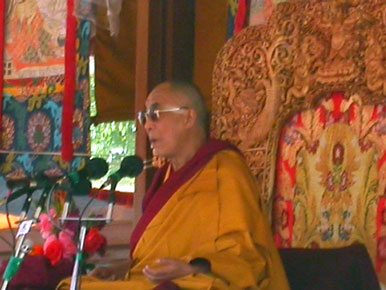
His Holiness the Dalai Lama preaching at Choglamsar on July 3, 2003
The crowd dispersing at the end of the sermon presented us with a parade of Ladakhi society, both religious and lay.
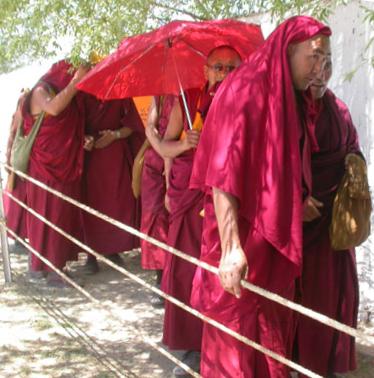
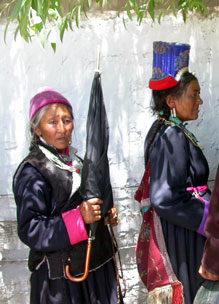
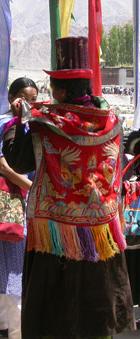
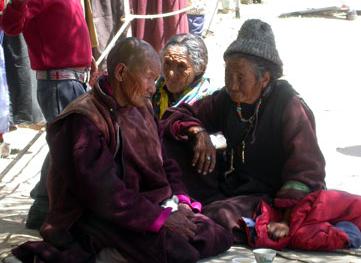
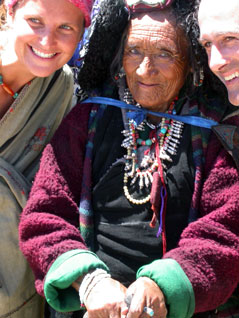
This Ladakhi lady, in her traditional fancy turquoise-stone headdress,
was much sought after by tourists as a photo companion
Perhaps to balance out the loftiness of the Dalai Lama, in the afternoon we sought out a few hours of degrading pop culture. After a bit of a hunt, we found what we were looking for at the huge Army camp a few kilometers outside of Leh, where a cinema played second-run Bollywood films for the homesick mainland Indian soldiers. The film was Maine Dil Tujhe Diya, and from our cushy sofas in the back row of the huge hall, we thoroughly enjoyed the antics of Salman Khan's brother (nobody seemed to know his name), Sanjay Dutt (whom Minette identified by the silhouette of his biceps well before his face was visible to the camera), and friends.
The next morning we had to get up very early to catch our flight back to Delhi.

Sunrise from Skit Tsal Guest House on the day of our departure
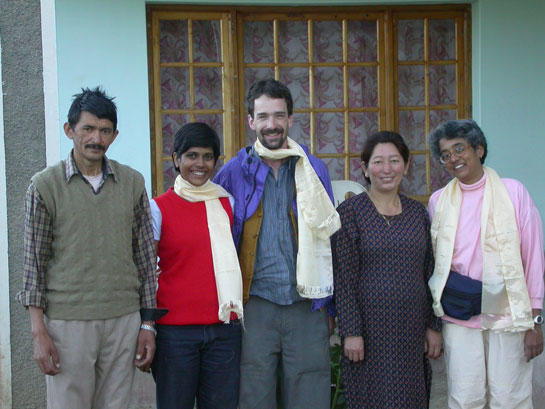
Phunsophji and Dolma, our hosts at Skit Tsal, with Minette, Matt, and
Jayashree. We are wearing scarves with Buddhist motifs
presented to us by our hosts.
Taking off from Leh, the plane first follows the Indus Valley west for some time before gaining enough altitude to bank left and cross over the Stok Range and then the rest of the Himalaya. The views were unbelievable, and David bravely defied--for the sake of art, of course--the official ban on photography over Indian territory.
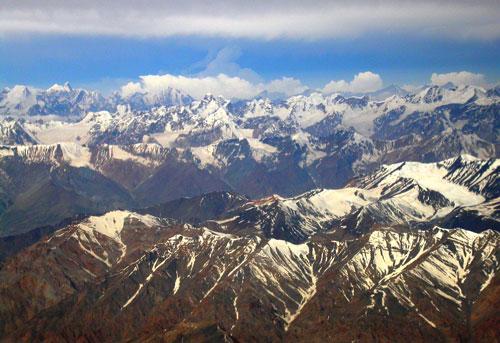
Out of this world!
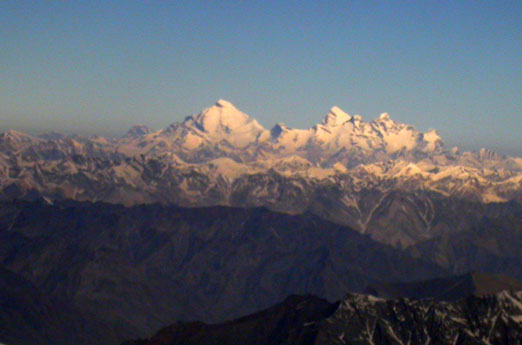
Nun (7,135m) and Kun (7,077m ), south of Leh in
the Stok-Kangri range of the Zanskar mountains, are the highest summits
in Indian Kashmir.
After a half hour or so we crossed the line of the monsoon: a row of towering stormclouds, and from there solid cloud cover extending southward, probably all the way to the Indian Ocean. Soon we were on the ground in Delhi, where the heat and humidity welcomed us back to India proper.
Back to main page